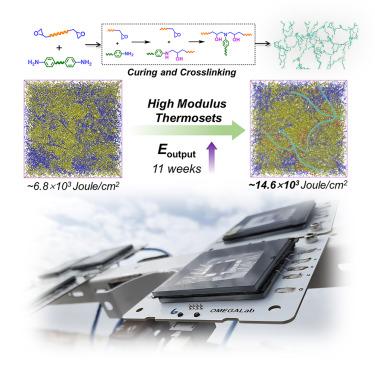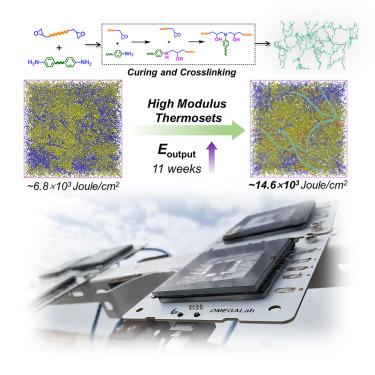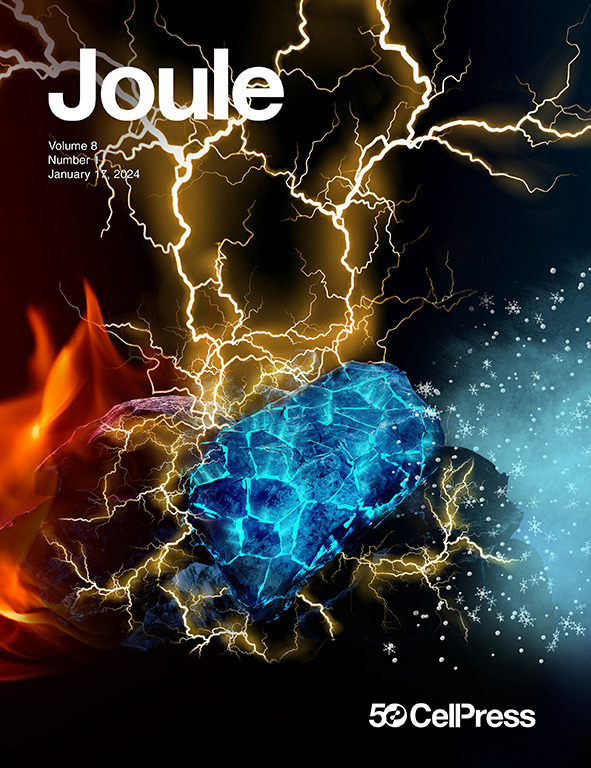In situ formation of thermoset matrices for improved stability in organic photovoltaics
IF 38.6
1区 材料科学
Q1 CHEMISTRY, PHYSICAL
引用次数: 0
Abstract
The performance of organic photovoltaics (OPVs) has rapidly increased. Yet, achieving long-term stability in the nano-morphology and thereby sustaining device performance remains challenging. Herein, we show that incorporating in-situ-forming cross-linked thermoset (CLT) matrices into the bulk heterojunction blends is a simple, general, and efficient strategy for high-performing and resilient OPVs. Our simulations and experimental data prove that these high-modulus CLT matrices featuring hydrogen-bonding interactions can freeze the nano-morphology, resulting in long-term thermal and photostable OPV devices. We demonstrate that this approach works efficiently with eight different blends and show that OPV devices can withstand 85°C for 1,000 h without losing performance. Blends with CLT matrices double the energy generated from OPV devices, showing an energy density output of 4,054 mW⋅h cm−2 over an 11-week operating period under outdoor conditions. This methodology opens avenues for both developing new thermoset networks for OPV and their use in other optoelectronic applications.


原位形成热固性基质,提高有机光伏技术的稳定性
有机光伏(OPV)的性能迅速提高。然而,要实现纳米形态的长期稳定性,从而保持器件性能,仍然具有挑战性。在本文中,我们展示了在体异质结混合物中加入原位形成的交联热固性(CLT)基质是实现高性能和弹性 OPV 的一种简单、通用和高效的策略。我们的模拟和实验数据证明,这些具有氢键相互作用的高模量 CLT 基质可以冻结纳米形态,从而产生长期热稳定性和光稳定性的 OPV 器件。我们用八种不同的混合物证明了这种方法的高效性,并表明 OPV 器件可以承受 85°C 的温度达 1,000 小时而不降低性能。使用 CLT 基质的混合物可使 OPV 器件产生的能量增加一倍,在室外条件下运行 11 周后,能量密度输出为 4,054 mW⋅h cm-2。这种方法为开发新的 OPV 热固性网络及其在其他光电应用中的使用开辟了道路。
本文章由计算机程序翻译,如有差异,请以英文原文为准。
求助全文
约1分钟内获得全文
求助全文
来源期刊

Joule
Energy-General Energy
CiteScore
53.10
自引率
2.00%
发文量
198
期刊介绍:
Joule is a sister journal to Cell that focuses on research, analysis, and ideas related to sustainable energy. It aims to address the global challenge of the need for more sustainable energy solutions. Joule is a forward-looking journal that bridges disciplines and scales of energy research. It connects researchers and analysts working on scientific, technical, economic, policy, and social challenges related to sustainable energy. The journal covers a wide range of energy research, from fundamental laboratory studies on energy conversion and storage to global-level analysis. Joule aims to highlight and amplify the implications, challenges, and opportunities of novel energy research for different groups in the field.
 求助内容:
求助内容: 应助结果提醒方式:
应助结果提醒方式:


